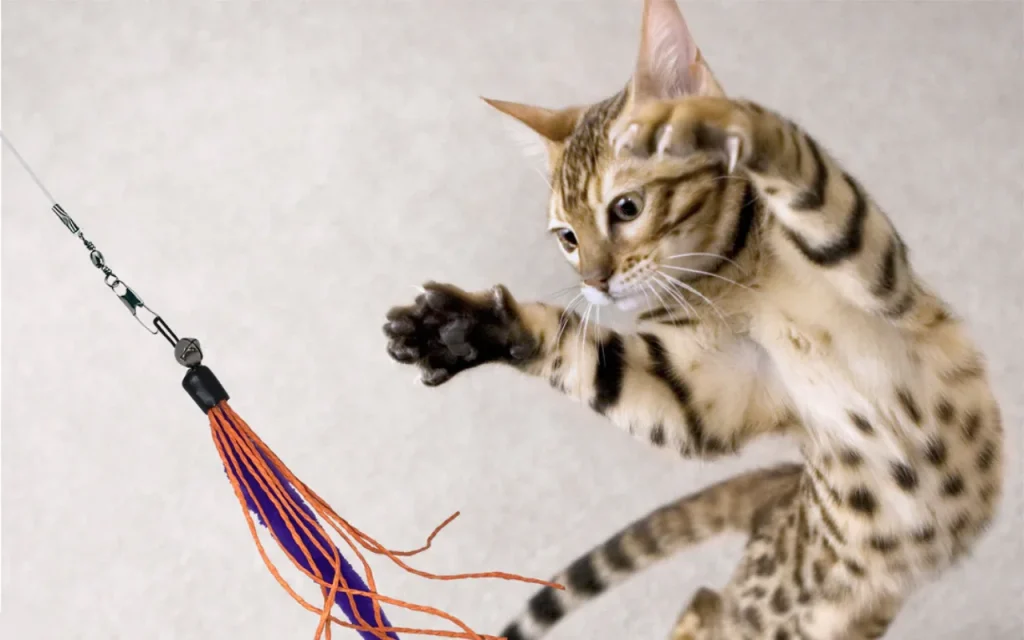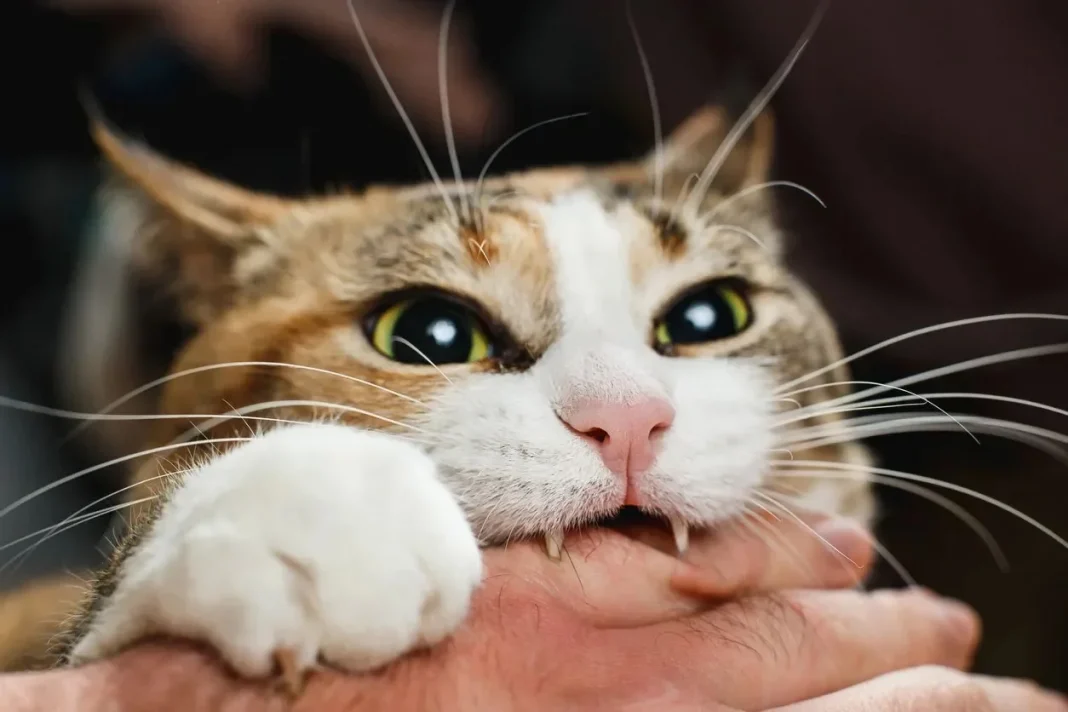Ugh, cat bites! Whether it’s a playful-but-way-too-sharp nip from your little kitten or a more startling chomp from your grown-up cat, let’s be honest, it’s no fun being on the pointy end of those teeth. It can leave you feeling a bit frazzled, maybe a little confused (especially if you were just having a nice cuddle!), and perhaps even a tad wary of those otherwise adorable murder mittens. If you’ve been wondering, “How on earth do I get my cat to stop biting me?”, please know, you’re so not the only one, and the really good news? There are definitely things we can do.
As a vet, believe me, questions about cat biting pop up all the time. And here’s a comforting thought: cats very rarely bite just to be mean. There’s almost always something behind it – maybe they’re treating your hand like a toy mouse, they’re feeling a bit overwhelmed, a little scared, or they’re actually trying to tell you something important. Cracking the “why” is a big first step. Then, we can gently show them some better, less ouchy ways to get their message across. And just so we’re clear, trying to punish them for it? That’s a no-go; it usually just ramps up their anxiety or makes them more defensive, which isn’t what anyone wants.
So, instead, let’s walk through some kind, genuinely effective, and vet-endorsed strategies to help you turn that biting habit around and get back to enjoying a more peaceful (and less tooth-marked!) life with your furry pal.
Hold On, Why’s My Cat Biting Anyway? A Little Cat Psychology

Before we dive headfirst into the solutions, it’s pretty helpful to have a quick think about why cats might bite in the first place. It helps make sense of the “how-to-fix-it” bits:
- Playtime Overdrive: This is a big one, especially with kittens and younger cats. They’re basically mini-panthers practicing their hunting moves, and your wiggling fingers or dancing toes can look like the best game in town. Often, they just haven’t quite learned that our skin isn’t as tough as their littermates’.
- “Too Much, Too Much!” (Overstimulation): You know how it is – you’re petting your cat, they seem to be loving it, purring like a tiny motor, and then, seemingly out of nowhere – OUCH! Some cats just hit a sensory overload point with too much touching, even if it started out feeling good. That bite is their rather direct way of yelling, “Okay, I’m done now, thanks very much!”
- Feeling Spooked or Defensive: A cat that’s scared might lash out with a bite if they feel trapped, get a sudden fright, or think something unpleasant is about to happen (like that dreaded nail clipper appearing!).
- “Ouch, That Hurts!” (Pain): If your normally sweet-natured cat suddenly nips when you touch a specific spot, pain could absolutely be the culprit. Think sore gums from dental issues, an arthritic joint in an older cat, or maybe an injury you haven’t spotted.
- “Hey, Pay Attention to Me!”: It sounds a bit cheeky, but yes, sometimes a cat learns that a quick nip is a surefire way to get you to look at them or interact – even if that interaction is you telling them off!
Keeping these common triggers in mind can really help you pick the best approaches from the list that follows.
8 Vet-Endorsed Ideas to Help Your Cat Bite Less
Alright, let’s get down to the nitty-gritty. These are methods that vets often suggest, and they really can make a difference.
1. Your Hands (and Feet!) Are for Cuddles, Not for “Combat”
- The Main Point Here: This one’s huge, especially if you’re dealing with a feisty kitten who seems to think your fingers are the greatest chew toys ever created. When you wiggle your fingers to get them to pounce, or let them “battle” your toes under the duvet, it might seem harmless fun when they’re tiny. But what you’re actually doing, without meaning to, is teaching them that human body parts are fair game for biting and scratching.
- How to Make it Work (Vet Perspective): Most vets would strongly advise you to always use proper toys when you’re playing with your cat. If your cat does happen to nip your hand when you thought you were just having a gentle moment, try to react with a soft but surprising “Ouch!” – not a full-on yell, just enough to make them pause. Then, and this is key, immediately stop whatever you were doing. Freeze. Don’t snatch your hand away super fast, as that can make them think it’s still part of the game. Once they let go, then you can slowly move your hand away. The lesson they learn is: “Oh, when my teeth touch the fun human, the fun just… stops.” Being really consistent with this is what makes it stick.
2. Let Them Be the Mighty Hunter (With Toys, Not You!)

- The Main Point Here: Cats are wired to hunt. It’s not just something they do; it’s a core part of who they are. They genuinely need a way to let out all that stalking, chasing, pouncing, and, yes, that satisfying “kill bite” energy. If they don’t get that fix through good, active play, well, your ankles might suddenly look like a very tempting substitute.
- How to Make it Work (Vet Perspective): Try to set aside time for at least a couple of good, focused play sessions every day – and really try to make it like a mini-hunt.
- Wand toys are your best friend: Things like feather wands, or toys with dangly bits on a string, are absolutely brilliant for this. Make the toy act like a little critter – have it dart behind the sofa, wiggle enticingly, then vanish, so your cat can properly stalk and pounce. And here’s a little tip vets often share: make sure you let them “catch” the toy successfully quite often. It stops them from getting frustrated and keeps them really into the game.
- Kicker toys are also gold: You know those long, soft toys they can grab with their front paws and then kick the stuffing out of with their back feet? They are perfect for letting your cat really unleash that “grab, bite, and wrestle” energy on something that’s not you!
- Remember, a physically and mentally tired cat is often a much less bitey cat!
3. Become a Cat Body Language Detective (Spotting the “Too Much” Cues)
- The Main Point Here: For those cats who tend to nip when they get a bit overwhelmed by petting, learning to spot their subtle “Okay, I’m getting close to my limit here” signals is a total game-changer. They usually give you little hints before they feel the need to resort to a bite.
- How to Make it Work (Vet Perspective): You really have to become a bit of a student of your cat’s non-verbal cues. Vets often coach owners to keep an eye out for these common signs:
- What’s their tail doing? Is it starting to twitch sharply from side to side, or maybe even thump a bit on the floor? That’s often a clear sign that their irritation level is rising.
- Watch their skin: You might see the skin on their back start to twitch or ripple – another little clue.
- Check their ears: Are their ears beginning to turn slightly back, or flatten out to the sides like tiny airplane wings?
- Feel the tension: Does their body suddenly feel a bit stiffer or more rigid under your hand?
- If you spot these signals, that’s your cue to stop petting right away and just give them some space. Doing this shows them you’re listening to their “cat language,” which builds a huge amount of trust and means they’re less likely to feel they must bite to make their point.
4. The “Ouch!” and Quick Stop: Speaking Their Language
- The Main Point Here: This idea is actually based on how kittens learn not to bite too hard from their mom and their brothers and sisters. You see, if one kitten in a litter bites another one too roughly during playtime, the one that got bitten will often let out a little yelp and stop playing. That’s how the biter learns, “Oops, that was too much, I need to be gentler next time.”
- How to Make it Work (Vet Perspective):
- A surprising sound, not a scary one: If your cat gives you a nip during play or when you’re interacting (and we’re not talking about a serious, aggressive bite here), try letting out a quick, sharp “Ouch!” or “Eep!” It shouldn’t be an angry yell that terrifies them, just a sound that’s surprising enough to make them stop and think for a second.
- The fun ends NOW: The very moment you make that sound, all interaction stops. If you were petting them, take your hand away (slowly, remember!). If you were playing, drop the toy. You can then either walk away or just turn your back for a minute or two.
- Getting everyone in the house on board with this is super important for consistency. The message your cat gets is crystal clear: “When I bite, all the good stuff – like attention and playtime – suddenly disappears.” Vets often highlight that this isn’t about punishing them; it’s about a clear, immediate, and understandable consequence.
5. Give Them a “Panic Room” (Their Own Safe, Chill-Out Zone)
- The Main Point Here: You know, every cat, but especially one that might be a bit on the anxious side or easily overwhelmed, really does need a special spot in the house where they know they can go to get away from it all and feel completely safe and undisturbed. Honestly, this can make a world of difference to their overall stress levels, and a less stressed cat is often a less bitey cat, particularly if the biting comes from fear or anxiety.
- How to Make it Work (Vet Perspective):
- Set up a comfy little haven for them – maybe it’s a plush bed in a quiet corner of a room, a high-up shelf on their cat tree where they can watch the world go by, or even a cozy carrier (with the door always left open so they don’t feel trapped) – and make this their personal “do not disturb” zone.
- And here’s the number one rule for this safe spot: when your cat is in there, everyone in the house (that includes guests and kids too!) needs to respect their space and leave them be. No trying to force cuddles, no picking them up.
- Giving your cat this kind of choice and control, as vets will confirm, really helps them feel much more secure and confident, and much less likely to resort to biting when they’re feeling a bit pressured or stressed out.
6. Could It Be Pain? (Time for a Vet Detective Visit)

- The Main Point Here: This one is so, so important. If your cat, who’s usually as sweet as pie, suddenly starts nipping, or if a biting habit they already had seems to get a whole lot worse out of the blue, please consider that there might be an underlying medical reason. Cats are absolute ninjas at hiding when they’re in pain.
- How to Make it Work (Vet Perspective): The best thing to do is to schedule a check-up with your veterinarian. They’ll want to give your cat a really thorough exam to look for things like:
- Sore teeth or gums (dental pain is a very common, but often hidden, reason for cats to get cranky and start biting!).
- Arthritis, especially in older cats, which can make being handled or even petted in certain ways quite painful.
- An injury you might not even have realized they have.
- There are also some other, less common, medical conditions that can lead to changes in behavior, including increased irritability.
- Think of your vet as your partner in this. Ruling out (or, of course, treating) any medical cause is always, always the first step before you dive too deep into behavioral solutions for any new or suddenly worse biting problem.
7. Catch Them Being Good! (Reinforce Those Gentle Moments)

- The Main Point Here: It’s easy to get focused on stopping the biting, but don’t forget to actively praise and reward the behaviors you do want to see! Cats, just like us, respond really well to positive reinforcement.
- How to Make it Work (Vet Perspective):
- When your cat interacts with you gently – maybe they rub their head on your hand without a hint of a nip, or they choose to play beautifully with a toy instead of your fingers – let them know they did great! This reward can be a tiny, super-tasty treat, some enthusiastic but gentle praise (“Good job, kitty! What a good, gentle cat!”), or a soft chin scratch (but only if that’s something they genuinely enjoy!).
- The timing here is pretty important; the reward needs to come as soon as possible right after they do the good behavior, so they make that crucial connection. Vets will tell you that this positive approach helps your cat understand much more clearly what it is you’re asking of them, rather than just what you don’t want.
8. Know When to Wave the White Flag (and Call in a Pro)
- The Main Point Here: Look, while these strategies really do work wonders for many common cat biting issues, sometimes you find yourself needing a bit more specialized help, and there’s absolutely no shame in that!
- How to Make it Work (Vet Perspective): Please don’t hesitate to have another chat with your regular veterinarian if:
- The biting is pretty severe or is actually causing injury.
- You’re starting to feel genuinely afraid of your cat.
- You’ve been giving these methods a really consistent, fair try for a good few weeks and you’re just not seeing any real improvement, or maybe things are even getting a bit worse.
- Or, as we mentioned before, if you’re really just not sure why your cat is biting.
- Your vet can offer more advice tailored specifically to your cat. And, if they think it’s needed, they can refer you to someone who’s a real specialist in animal behavior – usually a board-certified veterinary behaviorist (you might see DACVB after their name) or a certified applied animal behaviorist (CAAB). These are the folks who can really dig deep into complex behavior puzzles and help you map out a very specific, individualized plan for your cat.
Remember, Patience and Consistency are Your Secret Weapons
Changing a cat’s biting behavior rarely happens overnight. It almost always takes time, a big dose of patience, and making sure everyone in your house is on the same page with the approach. Try to remember, your cat isn’t biting just to be naughty or to annoy you. They’re communicating in one of the primary ways they know how. By making an effort to understand their world, giving them good outlets for all their natural catty instincts, and gently teaching them the “rules of engagement” in our human world, you really can build a much more loving, trusting, and wonderfully bite-free bond. You can do this!











